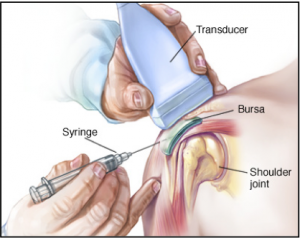by Dr. Demitri Adarmes
Ultrasound guided injections are used for multiple treatment options. They can temporarily dull pain before surgery or provide relief for those that are unable to undergo surgical treatment for a physical ailment.
In some cases injections are used to remove fluid from a joint or to prevent fluid from returning  to a joint to reduce pain in this area. Medical conditions such as tendinitis or arthritis often benefit from the use of ultrasound guided injections to minimize pain symptoms. These injections can be used to help manage swelling, acute or chronic pain.
to a joint to reduce pain in this area. Medical conditions such as tendinitis or arthritis often benefit from the use of ultrasound guided injections to minimize pain symptoms. These injections can be used to help manage swelling, acute or chronic pain.
An ultrasound can be used during an injection to help the workers compensation pain management doctor determine the proper placement for the needle. Locations for injections will be selected based on the swelling, inflammation or fluid present in this area.
Once an appropriate location has been determined for an injection, it will be carefully cleaned and marked. Then a local anesthesia will be placed on the skin so it will be numbed and unaffected by the procedure. A steroid, anesthetic or combination of these treatment options will then be injected into the spot determined by the ultrasound as necessary. Patients can then wait in a recovery area until they are able to stand and walk, at which point they may return home.
Before an Injection Procedure
Patients that are preparing for a guided injection procedure can continue to take their regular medications unless their doctor has expressly given them alternate instructions. Those that use blood thinners as part of their daily medical routine should check with their health care provider to ensure that this will not cause complications with the injection. Any medications you will be taking the day of your injection should be taken with small sips of water to reduce your risk of complications as well.
Follow-up for Your Injection
 Those that undergo an ultrasound guided injection are typically given a pain journal and will be asked to track their pain for at least a week following their procedure. Plan on bringing this journal to your follow-up procedure so you can discuss your progress with your work comp doctor.
Those that undergo an ultrasound guided injection are typically given a pain journal and will be asked to track their pain for at least a week following their procedure. Plan on bringing this journal to your follow-up procedure so you can discuss your progress with your work comp doctor.
This will help your Arizona injury doctor determine if the injection procedure has been successful. It is not uncommon to feel numb in the area where the injection was administered if you received an anesthesia treatment. This may last for up to 1-6 hours and does not need to be noted in your pain journal. It is also common for your pain to be slightly worse for a short period after your procedure. This should be noted in your pain journal.
It is also important to keep the injection site from your procedure dry and clean for 24 hours.  You can easily manage this by keeping a bandage over the affected skin for 2-3 days. If you are sore at the injection site, apply an ice pack to reduce your discomfort, or take an over the counter pain reliever such as Tylenol, Aleve or Motrin. If you are concerned about this interfering with your other treatment, ask your doctor what medications are safe to take and how often you should use them.
You can easily manage this by keeping a bandage over the affected skin for 2-3 days. If you are sore at the injection site, apply an ice pack to reduce your discomfort, or take an over the counter pain reliever such as Tylenol, Aleve or Motrin. If you are concerned about this interfering with your other treatment, ask your doctor what medications are safe to take and how often you should use them.






Leave A Comment